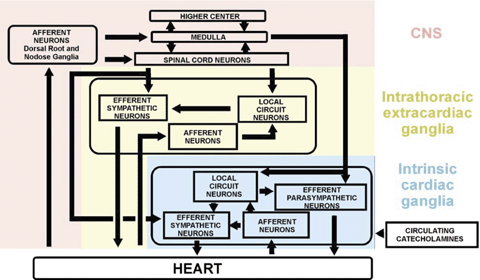J. Andrew Armour is a Canadian physiologist who has published quite a few papers on the regulation of the heart — a very complex subject. There are hormonal and external neuronal controls, and a specific tracery of internal neurons and neuron-like fibers that generate patterned muscle contractions. And muscle, of course, is itself called an excitable tissue because it has electrical properties that are essential for its function. There is a lot of cool stuff going on in cardiac research.
So, in 1991, Armour published on Intrinsic Cardiac Neurons in the Journal of Cardiac Electrophysiology. It’s solid work that summarizes these complex interactions, and explains how the heart has its own independent and relatively sophisticated independent electrical properties.
Physiological evidence indicates that afferent neurons, local circuit neurons, as well as efferent sympathetic and efferent parasympathetic neurons, are located in the mammalian intrinsic cardiac nervous system. Complex interneuronal interactions can occur between these neurons, as well as between such neurons and other intrathoracic and central nervous system neurons. A variety of neurochemicals have been proposed to be involved in such interneuronal interactions. Thus the electrophysiologic properties and synaptology of intrinsic cardiac neurons may be more varied than has been appreciated accounting, at least in part, for the variety of neuronal responses that in situ intrinsic cardiac neurons are capable of displaying. The various interactions that occur between intrinsic cardiac neurons and other intrathoracic neurons, as well as between neurons in all intrathoracic ganglia and the central nervous system, will have to be characterized in order to clarify the role of the autonomic nervous system regulating the heart throughout each cardiac cycle.
This is not revolutionary. It had all been pretty well known for decades, although Armour did a fine job of synthesizing all the pieces of the story.
In 2007, he also published a review of the importance of understanding cardiac circuitry, Potential clinical relevance of the ‘little brain’ on the mammalian heart, in Experimental Physiology. Again, this is good, useful, substantive stuff.
It is hypothetized that the heart possesses a nervous system intrinsic to it that represents the final relay station for the co-ordination of regional cardiac indices. This ‘little brain’ on the heart is comprised of spatially distributed sensory (afferent), interconnecting (local circuit) and motor (adrenergic and cholinergic efferent) neurones that communicate with others in intrathoracic extracardiac ganglia, all under the tonic influence of central neuronal command and circulating catecholamines. Neurones residing from the level of the heart to the insular cortex form temporally dependent reflexes that control overlapping, spatially determined cardiac indices. The emergent properties that most of its components display depend primarily on sensory transduction of the cardiovascular milieu. It is further hypothesized that the stochastic nature of such neuronal interactions represents a stabilizing feature that matches cardiac output to normal corporal blood flow demands. Thus, with regard to cardiac disease states, one must consider not only cardiac myocyte dysfunction but also the fact that components within this neuroaxis may interact abnormally to alter myocyte function. This review emphasizes the stochastic behaviour displayed by most peripheral cardiac neurones, which appears to be a consequence of their predominant cardiac chemosensory inputs, as well as their complex functional interconnectivity. Despite our limited understanding of the whole, current data indicate that the emergent properties displayed by most neurones comprising the cardiac neuroaxis will have to be taken into consideration when contemplating the targeting of its individual components if predictable, long-term therapeutic benefits are to accrue.
Here’s a diagram from that paper that might give you a visual depiction of what he’s talking about. It will look familiar to everyone who has taken a college level physiology course.
Now just take a moment and think about this. Here’s a piece of credible, robust science. How would an ignorant wackaloon interpret the story? Just close your eyes and let your imagination run riot for a while. Maybe you’ll come up with a wacky enough story that will make you rich. Or maybe you’ll come up with what you think is a crazy idea, but someone has already beaten you to it and published it.
After you’ve thought about a minute, you can go on and read the story of Gregg Braden. If you’ve got a loonier interpretation than he does, maybe you too can make good money on the New Age circuit!




